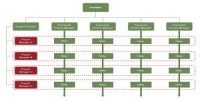Investors rarely place their entire wealth into a single asset or investment. Rather, they cons trust a portfolio. A portfolio is a combination of two or more securities or assets. Investors form portfolio to minimize the risk of investment and/or to maximize the return of through forming an efficient set of assets which either will maximize the return at a yen level of risk or will minimize the risk at a given level of return.
Theory of portfolio suggests that a portfolio should be a well-diversified combination of assets from a range of assets from the market having negative correlations. If we can properly diversify our investment the unsystematic or company specific risks can be eliminated. So we can say that a well-diversified portfolio assumes the systematic risk of investment only. In forming an efficient portfolio, Markowitz efficient set and .theory of optimal portfolio choice help investors and academicians to understand the zeal of portfolio formation.
Difference between portfolio risk and stand-alone risk:
Stand-alone risk:
- Definition: An asset’s stand-alone risk is the risk an investor would face if he or she held only this one asset.
- Risk measures: Individual standard deviation, Individual variance, Individual coefficient of variance etc.
- Diversification: Stand-alone risk measures the undiversified risk of an individual asset.
- Risk consideration: An asset stand-alone risk considers the total of an asset.
Portfolio risk
- Definition: A portfolio risk of an investment is where the assets are held as one of a number of assets in a portfolio.
- Risk measures: Portfolio standard deviation, Portfolio variance, Portfolio covariance etc.
- Diversification: A portfolio is constructed to diversify the risk arise from different sources.
- Risk consideration: A portfolio of asset considers the diversification risk only.















